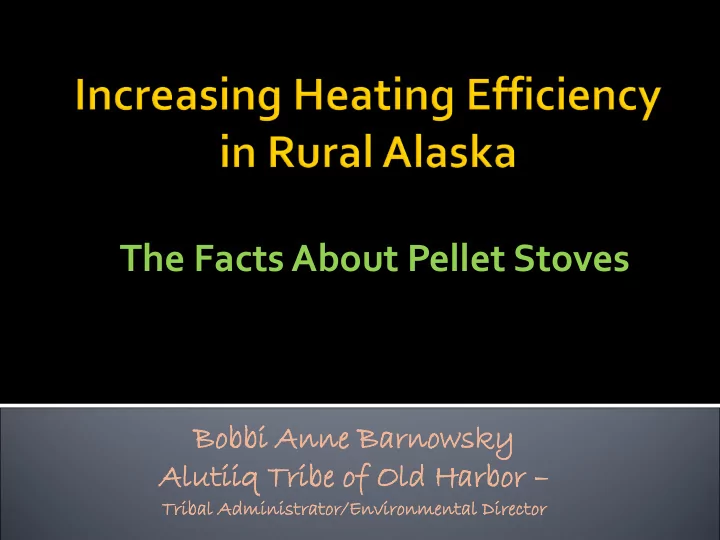

The Facts About Pellet Stoves Bobbi bi Ann nne Barnowsk nowsky Alu lutiiq tiiq Tribe ibe of f Ol Old Har arbor bor – Tribal bal Adminis inistrator trator/En /Enviro vironmental nmental Director ctor
you don’t see
AGENDA The Beginning of the Project The Thinking Cap There are many factors needed to make a decision. -Thinking what you want. How do I turn this idea into a -Types of homes. benefit to my -Finances. community? -Personnel -Time Available -Variables -Other factors
Wood Pellet Stoves: Are generally small Pellets are easy to store Easy to install and operate Use a hopper to load pellets Only loaded once a day - thermostat controlled
The Fire Factor: Fire is contained in a heat box inside unit. Creates minimum smoke. Outside of unit does not heat up as much. Create less ash than firewood. Gives off less creosote – pollutants, burns clean Less potential for fires.
Wood pellets can be made from recycled materials – bio mass fuel Have lower moisture content due to higher compression of pellets. Dry fuel creates more heat. They burn hotter and cleaner. They emit fewer pollutants. They are carbon neutral
Their DOWN Side………………. Initial Cost – Between $1,700 to $3,000 plus installation cost. Need storage space for pellets. Pre-made pellets may not be available nearby. The stoves run on electricity.
Important Considerations DIAGRAM Initial Cost Considersations . of Pellet Private expense or Stove Grants? Can I make enough pellets locally? How much do they Electrical cost to import? Power Availability Do I need a backup Supply Battery source for of Pellets power outages? Reliability
The pellet stoves run with electricity. The pellets are loaded into a hopper. A motorized auger (big screw) delivers the pellets into the burn pot. The auger’s speed determines the temperature of the stove. The faster it turns, the more pellets that are fed into the burn pot.
The burn pot is ignited. The pellets are compressed. The higher density and lower moisture creates a hotter flame. The ashes created are captured by an ash pot.
They heat a room through convection. A blower pulls clean room air in. Passes it through a heat exchanger. And blows the clean heated air back into the room. An exhaust blower blows the burned gases out a narrow pipe in the back of the stove and out the chimney.
It has a thermostat: It controls the auger which controls the number of pellets fed into the combustion chamber. More pellets equal more heat!
Top Feed: Pellets are fed from the top. Have better heat efficiency Mat clog up with ashes if not cleaned regularly Bottom Feed: They deliver pellets horizontally Can use lower grade pellets Produce less ash Less efficiency than top fed
They range in heating range from 8,000 to 90,000 BTU’s. The majority of models are between 40,000 to 60,000 BTU’s.
Manual stoves require a starter liquid or gel starter material to light the flame. Similar to starting a fire in a wood burning fireplace. Automatic stoves have start buttons with a self-igniter. When you push the button it feeds the pellets into the burn box.
To determine the capacity of the stove you need: 5,000 BTU’s will keep a 200 square foot of space warm. Check the square footage of the room you want to install it in.
Wood pellet stoves are only safe to sit on certain flooring materials. Decide the size of the pellet hopper for less frequent re-filling. If power outages are common, may need a battery backup…specially during winters. Stoves with large viewing glasses or ceramic logs are also available.
Project Planning: Example text Funding Grants and what they cover? Pellet makers Example text What type of equipment do we need to purchase? What type of training do we Example text Personnel need? Training
IGAP ANTHC Communtiy Demonstration Grant American Native Association – ERE Collection Fees Sale of Pellets
Wood Chipper Pellet Milling Machine Hammer Mill Paper Shredder Pellet Stoves Drill Three Phase Power Source Storage Containers Storage Facility
Personnel Equipment Fuel Storage Facility Storage Containers Electricity
Chip wood/shred paper and cardboard Put through hammer mill to get ¼” particle with 15% moisture Send through pellet mill Cool
20 lbs. per horsepower /hr. 7.5 hp. pellet mill 120 lbs. /hr.
Product Test Parameter As Received Dry Basis Moisture % 4.77 --- BTU/lb. 13639 14323 1. Eastern Coal Ash % 5.25 5.52 Sulfur % 0.76 0.08 Moisture % 25.67 --- BTU/lb. 9252 12448 2. Western Coal Ash % 4.21 5.66 Sulfur % 0.32 0.43 Moisture % 39.71 --- BTU/lb. 5356 8884 3. Raw Wood Waste Ash % 3.16 5.25 Sulfur % 0.05 0.09 Moisture % 10.37 --- BTU/lb. 7447 8309 4. Processed Wood Waste Ash % 1.73 1.93 Sulfur % 0.05 0.05 Moisture % 2.74 --- BTU/lb. 8246 8479 5. Wood Pellets Ash % 0.43 0.44 Sulfur % 0.01 0.01 Moisture % 4.04 --- BTU/lb. 10198 10627 6. Paper Pellets Ash % 3.53 3.68 Sulfur % 0.06 0.06 Moisture % 1.05 --- BTU/lb. 15278 15439 7. Tire Derived Fuel Ash % 3.49 3.53 Sulfur % 1.43 1.44 Moisture % 8.58 --- BTU/lb. 7830 8565 8. Peanut Hull Pellets Ash % 3.61 3.94 Sulfur % 0.08 0.09 Moisture % 12.56 --- BTU/lb. 6680 7640 9. Grain Dust Pellets Ash % 3.73 4.26 Sulfur % 0.09 0.11 Moisture % 14.18 --- BTU/lb. 7062 8229 10. Wild Rice Hulls Ash % 4.54 5.29 Sulfur % 0.11 0.13
Shipping to Rural AK Location 3 phase power Shredding Materials Communication
Bobbi Anne Barnowsky Tribal Administrator/Environmental Director Alutiiq Tribe of Old Harbor TSWAN – Program Coordinator Lepani Nadore Environmental Technician Alutiiq Tribe of Old Harbor bobbi.barnowsky@ohtcmail.org Lepani.nadore@ohtcmail.org 907-286-2315 office
Recommend
More recommend